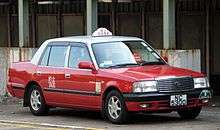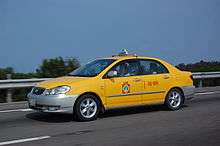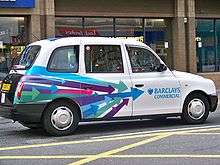Taxicab livery
Taxicab livery varies greatly from country to country. In some countries, livery is determined by Government legislation, in other countries, taxicab operators have choice on colours.
Africa
- In Egypt, taxicab liveries vary by governorate. The most iconic Egyptian taxis are those of Cairo (navy blue and white) and Alexandria (yellow and black), although a new Cairo livery (white with a black-and-white checkered strip along the center) has arisen in recent years, indicating those taxis with working meters.
Asia
Hong Kong

Taxicabs of Hong Kong have three color based on service area: red with silver top for urban Hong Kong; green with white top for New Territories; and blue with white top for Lantau Island. The color are to even out service between less densely populated areas and urban centres of the territory. Most taxis in Hong Kong are Toyota Comfort.
Indonesia

In Indonesia, there are many private companies operating taxis that have their own distinctive liveries. Limo and Almera are the common cars used for the regular taxicabs. VIP or executive taxicabs are painted in black. The first car used for the executive taxi was Nissan Cedric Y31 diesel. Now they are using Toyota Camry, Toyota Alphard, Toyota Vellfire, and different models of Mercedes-Benz.
India
In India, most taxicabs, especially those in Delhi and Mumbai, have distinctive black and yellow liveries with the bottom half painted black and upper half painted yellow. In Kolkata, most taxis are painted yellow with a blue strip in the middle (earlier in Kolkata it used to be yellow and black). However taxicabs are more common in Mumbai and Kolkata and not so much in Delhi (where autorickshaws are a more common sight). Private companies operating taxis can have their own liveries but need to get them approved from the government. Taxis and all other commercial vehicles have a yellow number plate so charging taxes and toll in highways is easier for the officials.
Israel
In Israel, taxis are painted white or any color no matter
Japan
In Japan, taxicabs each have color or designs based on the company. Most Japanese taxis are one of three types of cars: the Toyota Comfort; Nissan Crew; and Nissan Cedric Y31. They all have automatic passenger doors, which open when a button is pressed by the driver. However, elite taxis may have drivers that manually open the door for the passenger.
Recently, some taxi companies have selected Toyota Crown S170 and/or S180 as taxis because cars made for use as taxis (such as Comfort, Crew and Cedric) have very plain interiors.
Malaysia
In Malaysia, most taxicabs have distinctive white and red liveries. In Kuala Lumpur, well established meter taxi companies with more than 7500 units have bright orange color liveries with approval from the government. Private taxi operators however can be differentiated by the white and red livery while premium Executive taxis can be seen in blue livery.[1]
Pakistan
Most taxis in Pakistan are yellow painted while some old ones also run here with black colour and small of the upper half is yellow painted. There are also some privately owned companies which are running very good and latest model cabs in metropolitan areas such as Karachi, Lahore and Islamabad. These private companies use latest model locally assembled Toyota Corolla and Suzuki liana. There are also some companies offering Japan assembled cars in which Mitsubishi Lancer is popular.
Taiwan

In Taiwan, taxicabs are painted yellow prior to obtaining registration. The bumper may retain its factory colors by owner preference. The body may bear sponsored advertisements.
Europe
Germany

In Germany, taxicabs are beige, a look that was officially stipulated by law as Elfenbein a light ivory-color in 1971. In 2005 this legal restriction was lifted, but most taxicab drivers associations and companies still prefer the unified look and visibility of beige. Most taxicabs in Germany are Mercedes-Benz limousines, predominantly of the E-Class series.
Greece

In Greece taxicabs have variable colors, according to the city they are registered. For example, in Athens they are yellow (see: ). In all rural areas, they are usually silver-colored. In other cities except Athens they have particular color, such as blue with white-coloured roofs (Thessaloniki), dark red (Patras) or dark green (Ioannina). Cars used as taxis are mostly 4-door sedans with great luggage space. The cars used most as taxis are Mercedes-Benz C- and E-Classes, VW Passat, Škoda Octavia and Toyota Avensis. Most of them in urban areas are equipped with GPS navigation systems.
Ireland
_1.6_Ambiente_sedan_(The_Diamond%2C_Donegal%2C_June_2012_(03)_(cropped)).jpg)
Irish taxis do not have a specific color regulation and can be any color, as long as they have a roof sign with the word "TAXI" or "TASCAÍ" (Irish for "taxi"), the license number, and the county code (D=Dublin, SO=Sligo, G=Galway, W=Waterford, for more see Vehicle Registration Plates of Ireland) for the county where the taxi is from. The vehicle also needs to have a green and blue "TAXI" or "TASCAÍ" sign on both front doors in a specific design.
Italy
In Italy, taxicabs used to be green and black since the time of World War II, but were eventually changed to a bright yellow color. More recently, the color was changed to white.
.jpg)
Netherlands
.jpg)
Although not all taxicabs carry the usual taxi signs, all vehicles that are in use as regular taxicabs are required by law to carry light blue licence plates with black lettering.
Portugal
In Portugal, taxis were traditionally black with the upper half painted green. This was changed to a uniform beige color in the 1990s, but in the 2000s (decade) many new taxis have gone back to the traditional livery.
In Madeira, taxis are yellow with a stripe of light-blue in the middle.
In Azores, taxis were black and green like in the continental Portugal. Nowadays, since the 1990s, taxis are beige with two diagonal blue lines on the rear doors.[2]
Mercedes C- and E-class are popular taxicab models.
Russia
In Russia some companies are offering a 'luxury' taxi service where taxis are Maybachs and TechArt Magnums (tuned Porsche Cayennes) - but most cabs are operated by more 'conventional' brands, such as Ford Focus or Renault Kangoo in larger cities and Russian makes elsewhere.
Scandinavia
In Scandinavia there is no particular color for taxicabs.
Serbia
In Serbia taxicabs are operated by numerous small private companies. They can be of any color, but they must prominently display the company name and phone number.
Spain
_(cropped).jpg)
In Spain, each town and city designates the color of their taxis, but in the overwhelming majority, it is white, usually with some kind of color detail and/or local symbol on the doors. For example, in Madrid (and also in Almería), taxicabs are white with a red diagonal stripe going through the front doors; in Seville, they are white with a diagonal yellow stripe down the rear doors; in Bilbao, white with a horizontal red stripe on the front doors, etc. A notable exception is Barcelona, where taxicabs are fully black, except the doors and the boot lid, which are painted yellow.
United Kingdom

London taxis are traditionally black, with the term "black cab" meaning a licensed taxi with a meter. There is no actual livery requirement for London taxis although most are in fact painted black. Outside of London taxi licensing is the responsibility of the local authority, which may require taxis to be painted in a particular livery as a licence condition.
In another sense of livery, the Worshipful Company of Hackney Carriage Drivers became a City of London Livery Company in 2004.
North America
Caribbean
Three-wheeled Coco taxis, named because their shape resembles that of a coconut, are used in Havana, Cuba.

.jpg)
In Trinidad and Tobago, Maxi taxis that are colour-coded to a specific area, taxicabs are not colour-coded.
Central America
Costa Rican taxis are colored red. Usual cars for taxi use are Hyundai Accents, Toyota Coraxi (a cab version of the Toyota Corolla) and the Nissan Sentra (B13).

U.S and Canada
In the United States and Canada, many older taxi companies are named according to their paint schemes. Thus, "yellow cabs" are painted yellow, checker taxis are a play on the car manufacturer's name (Checker Motors) and have a distinctive black-and-white or black-and-yellow checkerboard stripe around their bodies, "Blue and White Cabs" might have blue bodies and white roofs, and "Black Top" and "Red Top Cabs" have black and red roofs respectively. In the 1920s, a famous company named "Brown and White" lost a lawsuit to prevent other taxi drivers from painting their cars these colors.
Some Canadian cities such as Toronto and Vancouver have taxis with their own custom color, but Montreal-area taxis (mostly mid-size cars such as the Chevrolet Malibu and Toyota Camry) remain stock.
In the late 1960s, New York City ordered that the city's taxis be painted yellow.[3] This sometimes led to confusion for New York visitors to Toronto, where police cars had yellow livery from the 1960s until they were phased out starting in 1986.[4] Most Toronto cabs had two-tone livery.[5]
In Honolulu, Hawaii, most taxis are luxury cars such as Lincoln Town Cars and Lexus ES350s and GX470s. These cars are left stock colored.
Mexico City's ubiquitous VW Type 1 (Beetle) cabs were green and white (being firstly yellow) by law until early 2003. However, the tiny cars had been displaced by bigger four-door sedans, the Nissan Tsuru, a Sentra MkIII (B13) based saloon and recognized for their red/white (or silver) body color. No VW are colored this way anymore. Matchbox released a scale model of the VW taxi in 2004, numbered 31. It is common that every six years, when Mexico city elections are concluded, the recently elected mayor changes the livery of the public transportation.
Oceania
Australia
_XT_sedan%2C_Black_Cabs_peak_service_taxi_(2015-07-10)_01.jpg)
In Australia, livery is determined by state legislation. In Victoria, an all-yellow scheme is adopted.[6] In contrast, in Queensland and New South Wales livery is dependent on which company is operating the dispatch system the taxi uses. In South Australia, most taxis are white. In the Australian Capital Territory All taxis are white while only recently (early 2011) upon request by some operators, the two main operators are moving from rear window and the old boot-lid mounted advertising to body-wrap advertising while both corporate and limousine services have silver livery on their cars.
South America
Argentina

In Argentina, each city designates the color of their taxis. The most common combination in major cities is yellow and black in different proportions (Buenos Aires, Rosario, Mendoza, Mar del Plata, Río Cuarto, Córdoba, San Salvador de Jujuy, among others), but throughout the country, white is predominant, sometimes combined with other colors (cities like La Plata, Berazategui, San Juan, Bariloche).
Taxis in Salta are red (or dark red) with a black stripe. In Quilmes, they are silver-colored (occasionally gray or even dark gray).
There are many cities that don't have a defined livery. These taxis can be identified by their roof sign and can be found in cities like Ushuaia, Formosa, Corrientes or Catamarca.
Brazil

Brazilian taxis are colored red in Porto Alegre and Londrina, orange in Curitiba, yellow in Rio de Janeiro and white in São Paulo, as each city defines its own regulation.
References
- ↑ Tan, Paul (22 October 2008). "Proton Saga Campro 1.6 Taxi with NGV". paultan.org. Retrieved 12 January 2013.
- ↑ "Atividade de Transporte Público de Aluguer em Veículos Automóveis Ligeiros de Passageiros (Táxi)Licenciamento de Veículos (Táxis)".
- ↑ "THE MODERN TAXI: 1960 – 2010". nyc.gov.
- ↑ "A History of Policing in Toronto - 3 -". torontopolice.on.ca.
- ↑ "A visual history of Toronto taxicabs". blogTO.
- ↑ http://www.taxi.vic.gov.au/DOI/DOIElect.nsf/$UNIDS+for+Web+Display/3E9B1A7375F1E84BCA2574EB0016D3F5/$FILE/Metropolitan%20taxi-cab%20peak%20service%20licence%20issue%20-%20TPSL%206-08.pdf